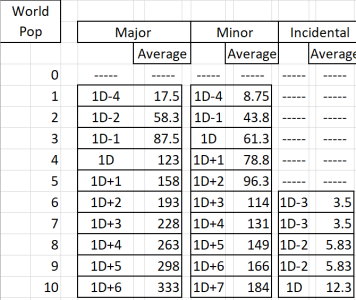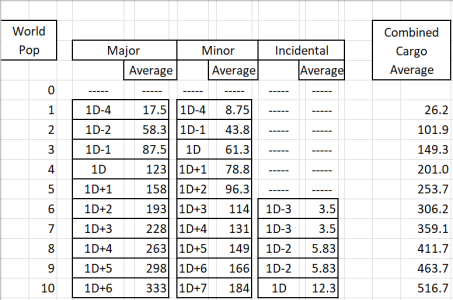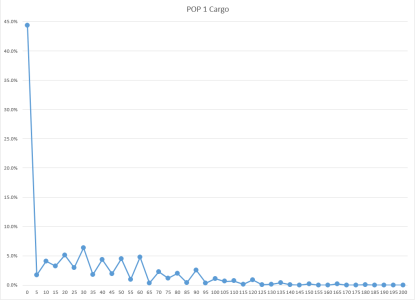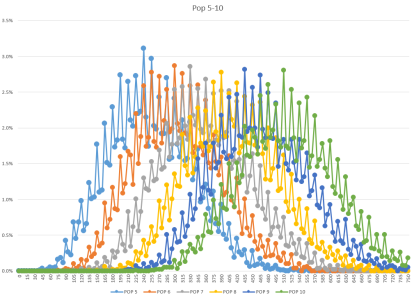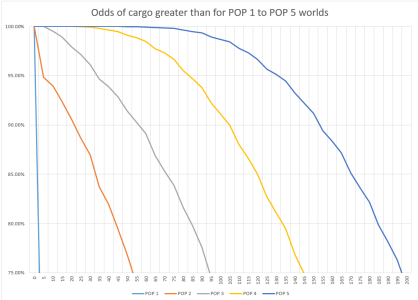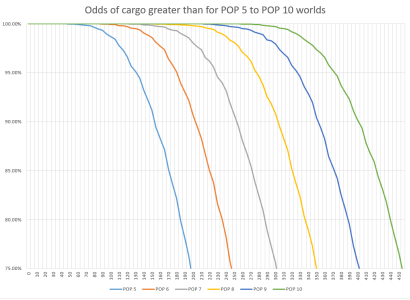The payment for the 400 Ton shop is ~395,000 plus crew salary, plus crew life support, plus 2x fuel, plus 1/12 of the annual maintenance is
The payment for the 600 Ton shop is ~566,000 plus crew salary, plus crew life support, plus 2x fuel, plus 1/12 of the annual maintenance is
Both starship designs can be TL=9 ... so if you spend 9 tons of cargo capacity in exchange for a TL=9 fuel purification plant, you won't need to buy starport fuel if you can wilderness refuel from oceans and gas giants.
400 tons J1 fuel requirement = 40 tons * 2 jumps per month * Cr500 refined fuel = Cr40,000 fuel cost reduced to Cr0
600 tons J1 fuel requirement = 60 tons * 2 jumps per month * Cr500 refined fuel = Cr60,000 fuel cost reduced to Cr0
A TL=9 fuel purification plant costs Cr38,000 at 100% construction cost for 9 tons.
In other words, after 2 jumps (!) the fuel purification plant will have "paid for itself" and will continue to add profit margin to the bottom line for the lifetime of the craft.
Just because you have a 400t cargo hold that doesn't mean you can fill it.

And this is where
regenerative biome life support laboratories can help (ironically enough) to mitigate the overhead costs of stateroom life support for passengers and crew (by reducing Cr2000 per person every 2 weeks down to Cr0 per person every 2 weeks). This shifts the expense from the operational overhead (life support) line item into the annual overhaul maintenance line item.
Type V-c regenerative biome life support will cost 2 tons per person for life support, which is the equivalent to 2 tons of cargo tickets (non-charter) which then do not need to be scrounged up from every starport you do business with. So if you've got 13 single occupancy staterooms (crew+passengers) you can just dedicate 26 tons to Type V-c regenerative biome life support along with a slightly higher crew manning requirement (steward and medical) in order to "shell game shift" the expenses of stateroom life support into a different column of the operational overhead expenses spreadsheet.
The net effect is that operational expenses go down and the "need" for tickets to pay for those operational expenses also goes down as the cargo tonnage available goes down. You ultimately wind up with lower expenses per starport destination and thus are better able to turn a profit on lower volumes of ticket sales, which puts smaller world markets "in play" as destinations you can turn a profit from going to.
Very very "shell game" type stuff, but it CAN make a difference to profit margins and provide a measure of "life support security" which really isn't touched on all that much in CT RAW ... which just assumes that it's possible/predictable to be able to obtain 2 weeks of life support consumables EVERYWHERE you go for a price of Cr2000 at any starport (regardless of starport type or world environment conditions), kind of like how you can "always" buy fuel from any type A-D starport (E and X provide no fuel). However, as soon as you take a deeper look at world environmental conditions, the idea that life support consumables are obtainable EVERYWHERE ... no questions asked ... so long as you've got Cr2000 per person for 2 weeks of endurance starts looking pretty preposterous. There are going to be places that are "so life support poor" that they can barely afford to keep themselves going on what food, water and air they have, never mind SELLING some of it to interstellar traders.
As soon as you start looking at (sub)sector maps and begin thinking in terms of "where should life support consumables be more/less expensive to obtain?" an entirely new "economic hazard" to merchant operations jumps out at you, with no reasonable solution other than to ... carry around more than 2 weeks of life support consumables supply, which then takes up some cargo space (for
Type IV life support) at Cr150,000 for 150 person/weeks per ton (CT Beltstrike, p3). That way, you've got a life support reserve to draw down and have the option of replenishment where the prices for life support consumables are cheapest, such as Rich and/or Agricultural trade coded worlds (for example).
As soon as you allow the cost for life support to ... vary ... including the possibility that there are going to be locations where a restock is NOT OBTAINABLE AT ANY PRICE (such as type E-X starports on worlds with Population: 0, for example) then questions of "range endurance" for starships can become an additional challenge that needs to be overcome by "professionals" in the field (merchants, military, etc.) and will rarely be kind to "amateurs" (PC Travellers, mainly). At that point, "bring your own life support with you" starts making a lot more sense when you can't just assume it's available anywhere and everywhere for exactly the same price (no matter what).
A more "advanced/expanded" version of the life support consumables requirement would set Cr2000 as the base price, but then use the Speculative Goods price modifier table (LBB2.81, p46) to determine the actual price to pay for life support consumables "this week" at each destination starport a starship goes to ... effectively turning life support consumables into a "speculative goods" item that is routinely available (except when it's not).
DMs to the roll for life support consumables price could be things like the UWP atmosphere and water codes, along with trade code modifiers.
So for example:
- Atmosphere: A+ applies a +(Atmosphere-6) DM
- Atmosphere: 3- applies a +(6-Atmosphere) DM
- Hydrographics 2- applies a +(3-Hydrographics) DM
- Poor worlds apply an additional +DM
- Non-agricultural worlds apply a +DM equal to their Population code

- Non-industrial worlds apply a small +DM
- Industrial worlds apply a small -DM
- Rich worlds apply a larger -DM
- Agricultural worlds with a tainted atmosphere apply a small -DM
- Agricultural worlds with an untainted atmosphere apply a -DM equal to their Population code

- Hydrographics 8+ applies a -(Hydrographics-7) DM
Totally a House Rule type of deal to "improve the simulation" (at the expense of additional bookkeeping), but also one that can make the economics of starship operations MUCH more dependent on THE MAP for which locations are viable/prime for interstellar merchants to be operating in. Having a "home port" at a Rich+Agricultural world where you can buy life support consumables CHEAP would make a LOT of difference to starship operators at ALL scales, not just ACS free traders vs BCS megacorp megafreighters.

That kind of "tethering" of starship operations to a "cheap" source of life support supplies based on UWP codes then adds a lot of "richness and texture" to (sub)sector maps when Refereeing a merchant context Traveller campaign.

After all, there's a reason for the saying, "Don't bite the hand that feeds you."



